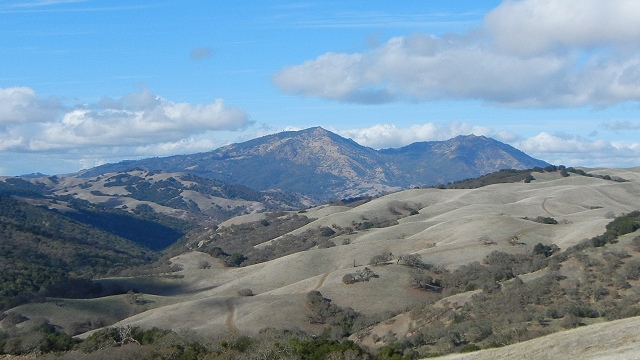
I’m pleased to extend the tradition of the Geological Holiday Quiz to KQED Science after a two-year run on the QUEST site. Previously it’s focused on the San Francisco Bay Area but this year the boundaries will broaden a bit. But some things will not change: no prizes are awarded but satisfaction is guaranteed; each post has one correct answer; and most of the answers have appeared in my blog posts on QUEST as well as KQED Science during the past year.
Answers appear at the bottom. Comments of all kinds are welcome.
—
- This beloved San Francisco landmark boasts an artificial cliff almost 200 feet high.
- “Anthropocene” means the age of:
(a) ants (b) apes (c) domesticated species (d) humans - What’s the name of those big hollows carved in our local sandstone?
(a) tabellae (b) tafelbergs (c) tafoni (d) talus - The authorities detect nuclear explosions with which of these tools:
(a) infrasound (b) solitons (c) ultrasound (d) wave packets - Taphonomy is the study of:
(a) faunal/floral succession (b) fossil preservation (c) rock deformation (d) species classification - What rock type gives Devil’s Slide its reputation:
(a) diabolite (b) granite (c) mudstone (d) serpentinite - The South Bay BART extension will:
(a) cross both the Hayward and San Andreas faults (b) cross the Hayward fault twice (c) cross the San Andreas fault twice (d) just miss the Hayward fault - The California gold syndicates left behind huge piles of:
(a) bricks (b) gold (c) granite (d) gravel - The state geological agency estimates that the Bay Area has less than a 20-year supply of:
(a) aggregate (b) air (c) petroleum (d) water - This year the changing magnetic field made Oakland Airport change the name of its:
(a) control tower (b) runways (c) security setup (d) terminal - Researchers recently found a species of microbe with a metabolism that requires:
(a) helium (b) plutonium (c) rare earths (d) tungsten - The world’s oldest ice occurs where:
(a) East Antarctica (b) Greenland (c) tropical glaciers (d) West Antarctica - The standard divisions of geologic time are marked by:
(a) golden spikes (b) impact craters (c) road signs (d) statute law - The Pakistan earthquake in September created what phenomenon seen in Southern California:
(a) a dance contest (b) a movie shoot (c) a mud volcano (d) an oil gusher - The world’s largest earthquake in 2013 was also its:
(a) deadliest (b) deepest (c) northernmost (d) worst for landslides - California’s biggest oil source has what geological name?
(a) the Bakersfield Formation (b) the Coalinga Sandstone (c) the Monterey Formation (d) the Yucaipa Schist - This year a government scientist argued that nuclear waste can be safely kept in:
(a) bauxite (b) lava (c) shale (d) steel - California differs from neighboring states by containing:
(a) a complete tectonic plate (b) a spreading rift (c) a subduction zone (d) a volcanic arc - The sand in San Bruno Mountain’s sandstone comes from:
(a) Idaho (b) Nevada (c) the San Andreas fault (d) Sierra Nevada - Bay Area earthquake faults are notable for being:
(a) creeping (b) on Twitter (c) parallel (d) quiet
And here are the answers:
- It’s Telegraph Hill, where century-old quarries have left high scars on the hill’s eastern side.
- d; specifically, it means the age in which human activity has become as influential as other geological activities (although you could argue for ants).
- c; see some excellent tafoni at Pebble Beach.
- a; infrasound is one of the methods used by the Comprehensive Test Ban Treaty Organization.
- b; the subject covers everything from the time an organism dies to the time its fossil is brought back to the surface.
- c; mudstone can be exceedingly weak, as it is at Devil’s Slide. The granite headlands immediately to the south are much stronger stuff.
- c; the existing Fremont-Richmond line just misses the fault at the Fremont Station.
- d; see some along the lower American River near Sacramento and many other places.
- a; the cost of aggregate (sand, gravel and crushed stone) is strongly controlled by transportation, and this essential commodity needs to be locally sourced.
- b; airport runways are designated by a numerical system based on their compass bearing.
- c; the microbe that in effect uses rare-earth metals as vitamins is the biochemical version of a diesel engine that can only burn jojoba oil.
- a; East Antarctica is the big side of Antarctica, and patches of its ice are estimated to be 1.5 million years old.
- a; “golden spikes” or GSSPs are precisely defined rock exposures that are the formally accepted boundaries between geologic time units.
- c; mud volcanoes are the least photogenic of these events, but they’re definitely a California thing.
- b; the 24 May earthquake in Kamchatka was 609 kilometers deep and the largest deep earthquake on record. No one was killed.
- c; learn more about this widespread rock unit here.
- c; the soft, clay-rich rock called shale is a better barrier to groundwater than even the toughest granite.
- a; the Sierra Nevada microplate fits within our borders. We share a spreading rift with Baja California Norte and share both a subduction zone and volcanic arc (the Cascades) with Oregon.
- a; a recent research paper found that zircon grains in the San Bruno Mountain terrane matched those in the Idaho Betholith, much farther away than we ever considered before.
- a, although the Hayward fault is active on Twitter—but not the Calaveras, or Rodgers Creek, or San Gregorio, or Concord, etc. Creeping faults are quite uncommon around the world, but our three major faults (Calaveras, Hayward, San Andreas) all exhibit creep.